 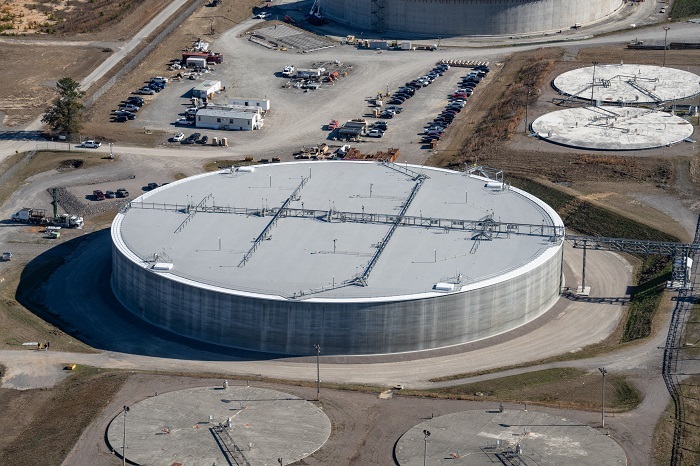 Saltstone Disposal Unit 9 is the latest mega-size disposal unit completed at the Savannah River Site, bringing the U.S. Department of Energy Office of Environmental Management and liquid waste contractor Savannah River Mission Completion a step closer to achieving the mission.
AIKEN, S.C. — The U.S. Department of Energy Office of Environmental Management (EM) has authorized the newest mega-size disposal unit to begin operating at the Savannah River Site (SRS), completing a 2024 priority for the cleanup program.
The authorization marks the last step before the Saltstone Disposal Unit (SDU) 9 can begin to receive decontaminated material for disposal. The unit was completed over $60 million under budget and seven months ahead of schedule.
Achieving significant construction milestones, such as SDU 9, is an EM priority and part of the cleanup program’s 10-year Strategic Vision, according to Jim Folk, DOE-Savannah River assistant manager for waste disposition.
“These units play a critical role in EM’s commitment to undertaking one of the largest environmental cleanup efforts in the country,” Folk said. “The mega-size saltstone disposal units are vital in our ability to safely dispose of legacy liquid waste and underscore DOE’s commitment to complete the SRS Liquid Waste Program.”
It wasn't the first time the liquid waste team at SRS fulfilled an EM annual priority by completing construction of a mega-size disposal unit. They met the challenge last year with SDU 8 and in 2021 with SDU 7.
 EM’s liquid waste contractor at SRS, Savannah River Mission Completion (SRMC), manages the construction and operation of the SDUs. Subcontractors Quality Plus Services, US FUSION & Specialty Construction, and DN Tanks completed the site preparation, interior and exterior liner systems, and unit construction.
The SDUs are the end of the salt waste processing path. The Salt Waste Processing Facility (SWPF) produces decontaminated material that is sent to the Saltstone Production Facility, where it is mixed with dry materials to make a cement-like grout. The grout is pumped into the SDUs, where it solidifies into a monolithic, non-hazardous form.
Radioactive liquid waste is generated at SRS as byproducts from processing nuclear materials for national defense, research, medical programs and for NASA missions. The waste — totaling 33 million gallons — is stored at SRS in two groupings of underground waste tanks known as tank farms.
SDU 9 is the fourth mega-size unit built at SRS and can hold up to 33 million gallons of saltstone. These larger SDUs are designed to support the increased material production from SWPF. The new SDUs result in more than $500 million in cost savings over the life of the SRS Liquid Waste Program because they require less infrastructure and materials than the previously planned 80 smaller SDUs.
SRMC is also in various stages of constructing the final SDUs needed at SRS — 10, 11 and 12. SDU 10 is under construction while sites have been prepared for SDUs 11 and 12 with mud mat construction beginning for SDU 11 this year.
The SDU 9 construction project was another well executed undertaking by the team, according to SRMC President and Program Manager Dave Olson.
“To safely and successfully complete a construction project of this magnitude required incredible focus, collaboration and talent by the entire team,” Olson said. “I am proud of the SRMC team’s accomplishment that brings us one step closer to completing our mission through this essential project.”
-Contributor: Dara Glass
 
WASHINGTON, D.C. — U.S. Energy Secretary Jennifer Granholm honored Idaho Cleanup Project (ICP) Manager Connie Flohr with the Secretary’s Exceptional Service Award in recognition of Flohr’s dedication and service to the Department of Energy (DOE) and nation. Flohr, who retires later this month, has spent most of her more than 23-year DOE career within the Office of Environmental Management (EM) in a wide range of leadership roles, including at EM headquarters and the ICP. As deputy manager and manager of the ICP, Flohr provided exemplary leadership overseeing all operational and business activities, while strengthening relationships with state and local stakeholders, according to the award citation signed by Granholm. Meanwhile, EM Senior Advisor William “Ike” White presented Flohr with a Distinguished Service Commendation on April 10, recognizing the ICP manager for her distinguished career service and leadership. “It is thanks to your exemplary performance that EM and DOE have realized significant accomplishments and has the EM team poised for sustained success in the future,” the commendation says. Flohr is pictured, clockwise from top left, with White, EM Principal Deputy Assistant Secretary Jeff Avery and members of the EM team.
 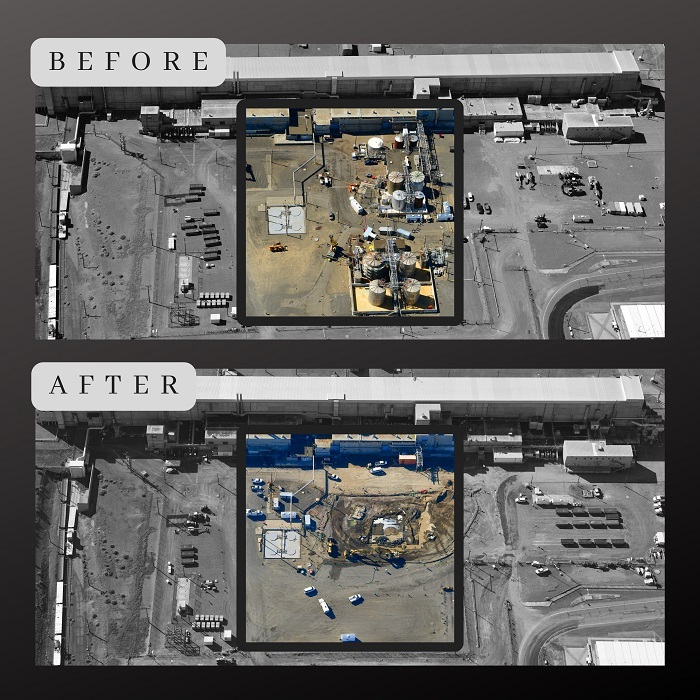 Demolition of two chemical storage areas at the Hanford Site’s Plutonium Uranium Extraction Plant has significantly changed the landscape near the largest of Hanford’s five former plutonium production facilities. Aerial images from July 2023, top, and March 2024, bottom.
RICHLAND, Wash. — Crews at the Hanford Site are reducing risk at the Plutonium Uranium Extraction Plant (PUREX), one of the site’s five former chemical separations facilities.
A team with U.S. Department of Energy Office of Environmental Management (EM) contractor Central Plateau Cleanup Company (CPCCo) recently finished demolishing a former chemical storage area that supported the nearby plant during Hanford’s operations to produce plutonium.
Demolition of the 211-A Chemical Storage Area included the removal of more than 20 empty tanks, a pumphouse and hundreds of feet of pipeline.
This is the second chemical storage area next to PUREX that workers have demolished, allowing crews to begin cleanup activities inside the main PUREX facility.
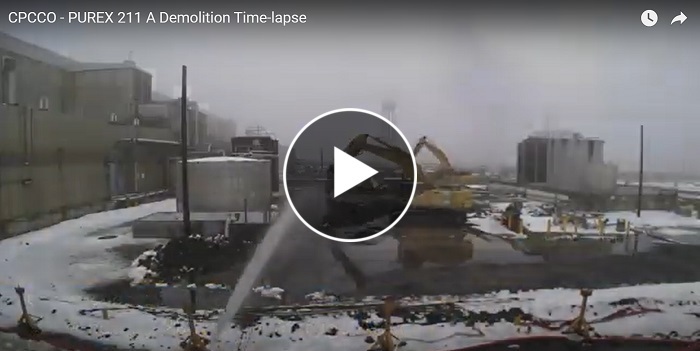 EMTV — Gone in a flash: Time-lapse video highlights demolition of a former chemical storage area at the Hanford Site.
“PUREX has undergone significant remediation efforts over the past few months,” said Andy Wiborg, EM project director at Hanford. “Our teams continue making tremendous progress to reduce risk on the Central Plateau of the Hanford Site by removing former processing and support facilities.”
PUREX was key to Hanford’s plutonium production mission during the Cold War era. The plant processed nearly 70% of Hanford’s estimated 20 million reactor fuel rods to recover plutonium for further processing.
“Completing demolition of PUREX North was a team effort,” said Robert Wade, CPCCo project manager. “Our crews have worked hard over the past two years to safely prepare and demolish both chemical storage areas.”
 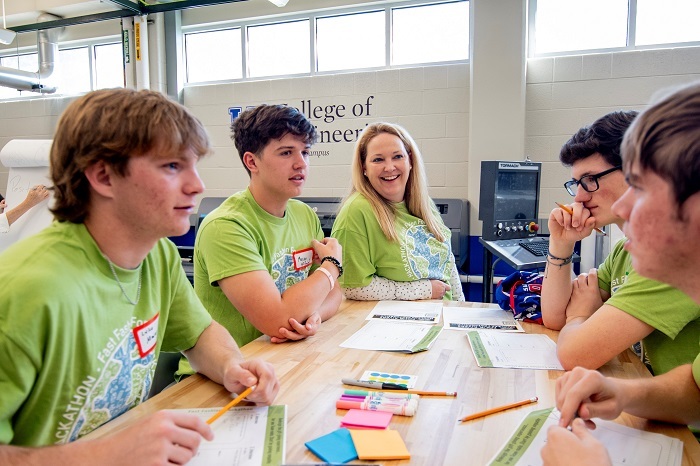 Massac County High School Teacher Megan Musselman, center, helps students brainstorm ideas during EcoThink’s “Fast Fashion” sustainability challenge. Teams of students were asked to think of ways to reduce, reuse or recycle clothing, tackling an emerging environmental problem.
PADUCAH, Ky. – Local high school students from western Kentucky and southern Illinois put their problem solving skills to the test during the annual EcoThink project, challenging themselves to address environmental and sustainability issues through critical thinking exercises focused on teamwork and engineering concepts.
“The students really enjoyed this opportunity,” Paducah Tilghman High School Teacher Amy Clark said. “They liked seeing other students’ thought processes and ideas. One student said the word engineering frightened her but realized it wasn't as scary as she thought.”
This year’s project focused on a “Fast Fashion” challenge and the environmental impact of manufacturing cheap, limited-use clothing. Students were tasked with finding ways to reduce, reuse or recycle clothing by determining buying habits, back-to-school shopping needs and how to impact culture changes with their peers. Solutions presented by the teams included creating a phone application and distribution centers for renting clothes and designing clothing that can be modified depending on the season or style.
The EcoThink project was led by U.S. Department of Energy (DOE) Office of Environmental Management (EM) Portsmouth/Paducah Project Office deactivation and remediation contractor Four Rivers Nuclear Partnership (FRNP).
“EcoThink is a great way to emphasize DOE’s mission for sustainability to students in the region,” EM Paducah Site Lead April Ladd said. “Not only does it bring awareness to real world problems, but by encouraging students to think about these problems, they may consider a career in science, technology, engineering and math (STEM), which will be critical as the next generation workforce is developed.”
EcoThink, which was featured at the 2024 Waste Management Symposia’s STEMZone, is conducted through a partnership between Sprocket, Inc. and University of Kentucky College of Engineering and sponsored by FRNP.
“Each year, I am impressed with the ingenuity displayed by the students who participate in EcoThink,” FRNP Program Manager Myrna Redfield said. “We appreciate all the teachers and volunteers who come together to make this event possible and look forward to growing and improving the program in the future.”
-Contributor: Dylan Nichols
 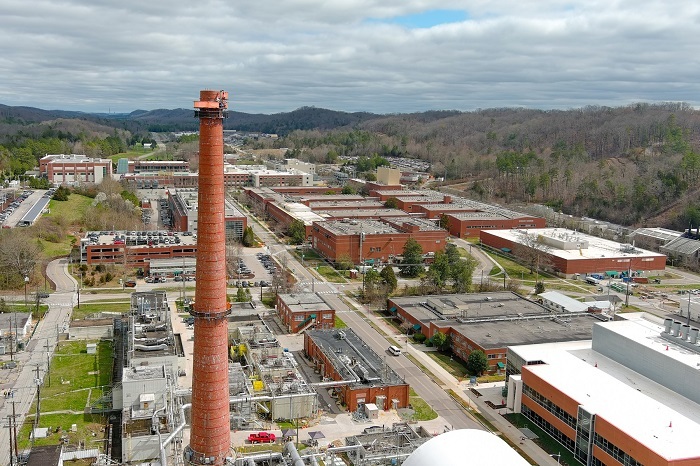 The 250-foot tall 3039 stack is one of the oldest structures at Oak Ridge National Laboratory, dating back to 1949. It is located in the heart of the site and provides essential support to ongoing operations.
OAK RIDGE, Tenn. – The iconic 3039 stack has towered over the Oak Ridge National Laboratory (ORNL) since the lab’s earliest days, providing ventilation to operations at the site. However, recent inspections revealed portions of the landmark had deteriorated and required repairs.
The Oak Ridge Office of Environmental Management (OREM) performs periodic inspections of the structure to identify any defects or other issues. In recent years, OREM and its contractor, UCOR, used drones to conduct those inspections to avoid having employees climb the towering structure, which could cause further wear and tear.
Information gathered from aerial photos proved the necessity for a full physical inspection. UCOR selected International Chimney Corporation as the vendor to conduct the inspection — the same company that built the stack 75 years ago.
Because of the amount of degradation at the top of the 250-foot stack, UCOR recently removed the top five feet of the structure and installed a new stack cap. During that period, operations connected to the stack were shut down.
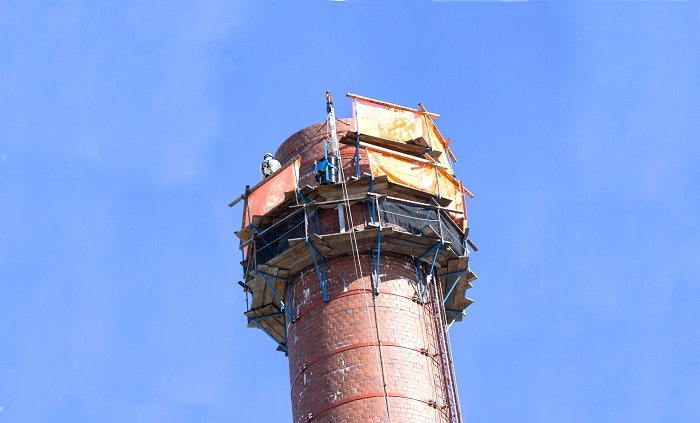 Due to advanced deterioration of the 3039 stack, crews removed the top five feet of the structure and installed a new cap to stabilize and protect the top of the stack.
Now, the repair work is complete, and operations have resumed.
“The 3039 stack, despite being one of the oldest structures at the site, still provides an essential function to ORNL operations,” said James Daffron, acting ORNL portfolio project director. “Maintenance is essential to ensure continued use of the facility.”
OREM expects the stack to remain in place for 10 more years before it’s taken down, so these repairs help ensure it continues operating safely in the heart of ORNL.
With the removal work completed, the stack has been successfully restarted and is once again providing ventilation to the site.
UCOR worked closely with ORNL management-and-operating contractor UT-Battelle and another site cleanup contractor, Isotek, to plan for the outage and ensure minimal impact to operations.
-Contributor: Shannon Potter
 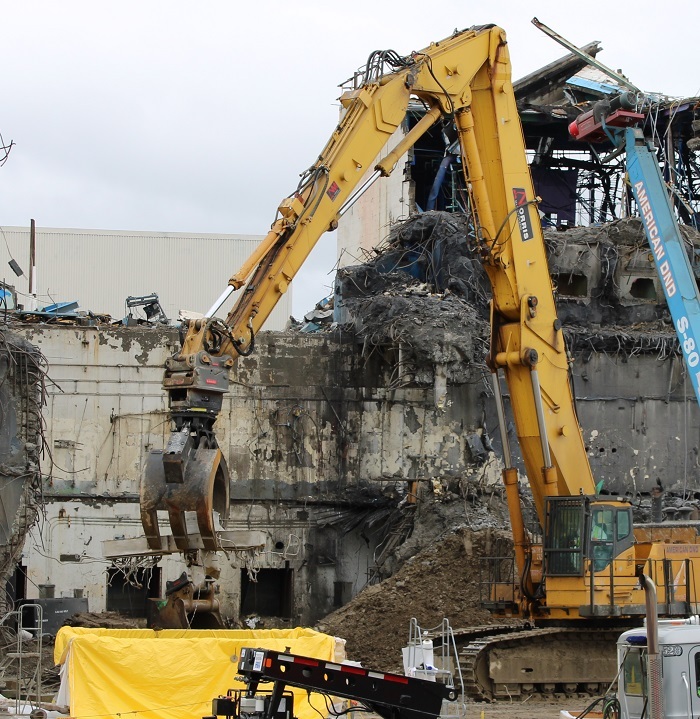 An operator uses a hydraulic grapple to safely remove and package a sampler system into a specialty shielded container for offsite disposal at the West Valley Demonstration Project.
WEST VALLEY, N.Y. – U.S. Department of Energy Office of Environmental Management (EM) crews safely removed a massive piece of equipment known as the “Green Giant” from a facility being demolished at the West Valley Demonstration Project (WVDP).
Painted green decades ago, the sampler system held samples from various vessels used in former spent fuel reprocessing operations at the WVDP. It weighed 1,100 pounds, with 75,000 pounds of steel and lead shield plates on the outside of it.
EM and workers with cleanup contractor CH2M HILL BWXT West Valley (CHBWV) removed the steel shield structure from a chemical processing cell as part of the ongoing demolition of the Main Plant Process Building. They packaged the sampler system for offsite disposal.
“This all comes down to planning,” said Stephen Bousquet, assistant director of West Valley’s Office of Project Management. “Working as a team and utilizing feedback and lessons learned helped to make this work evolution safe, smooth and compliant. When performing challenging work, safety must remain the top priority, and that’s exactly what this team did.”
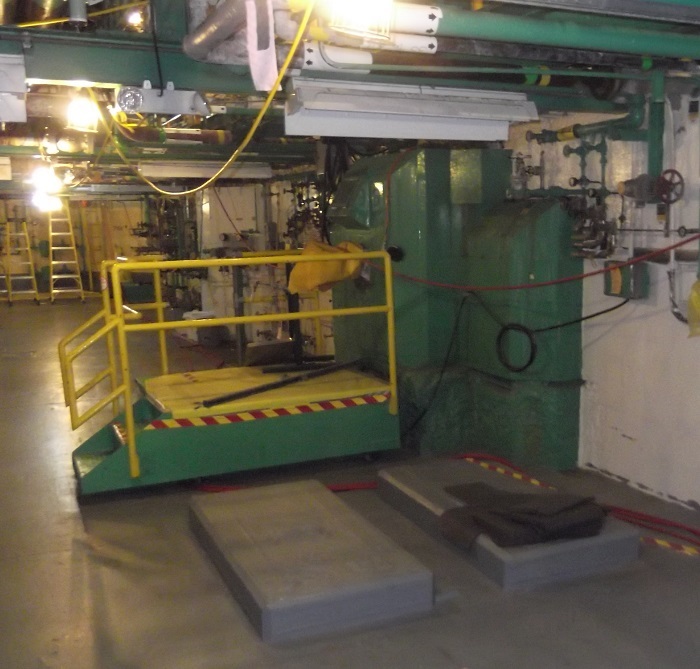 A view of the “Green Giant” inside a chemical processing cell within the Main Plant Process Building at the West Valley Demonstration Project.
The sampler system was embedded inside a wall in the Chemical Process Cell, which was designed to dissolve sheared spent nuclear fuel and reduce liquids through evaporation. The sampler system had an interface for operators in the Chemical Operating Aisle, where they obtained the samples from the vessels in the cell. The sampler system moved the samples to the Analytical & Process Chemistry Sample Storage Cell using a small elevator and conveyor inside the wall. Workers in that cell analyzed the samples to monitor the chemical dissolution of the spent nuclear fuel.
Prior to removing the sampler, a multi-disciplinary team identified more than 120 items in the Main Plant requiring special handling and packaging, including the sampler. This work also helped to determine the safest method for removal. In this case, crews built a special shielded box, and a heavy equipment operator used equipment to safely remove and package the sampler.
CHBWV Facility Disposition Manager Tom Dogal reiterated Bousquet’s sentiment about the factors leading to the project's success.
“Extensive planning, engineered controls and the right people allow us to perform our cleanup mission safely and compliantly,” Dogal said. “Teamwork and communication kept them focused on the task to ensure a smooth, deliberate and successful outcome.”
The Main Plant is one of the last major facilities at West Valley. Its successful demolition will further reduce environmental risks and position the site for the next phase in cleanup. The demolition is expected to be completed in the fiscal year that begins Oct. 1.
-Contributor: Joseph Pillittere
  Savannah River Site Production Operator Apprentices Dustin Bates, left and bottom right, and Brandon Watkins, top right, complete training funded by the Workforce Innovation and Opportunity Act.
AIKEN, S.C. — A partnership with a local economic development organization has provided qualified personnel to support the U.S. Department of Energy Office of Environmental Management program at the Savannah River Site (SRS) since 2020.
The SRS partnership with the Lower Savannah Council of Governments (LSCOG) has led to registered apprenticeship occupations in support of mission-critical positions at the site.
“When multiple dedicated organizations come together, there is nothing we can’t accomplish,” said Dorian Newton, director, SRS Site Training. “Since the start of our partnership, LSCOG has supported over 24 registered apprenticeship occupations and contributed to workforce development at SRS.”
Savannah River Nuclear Solutions, the site’s managing and operating contractor, established the first registered apprenticeship occupation in 2020 to address attrition levels and create a pipeline to support a thriving workforce. After expanding site-wide, the SRS Apprenticeship School has successfully graduated over 530 apprentices, and 91% of them have accepted full-time positions at the site.
“It’s a win-win for all involved,” said Booboo Roberts, SRNS program manager, Apprenticeship School and Pipeline Programs. “Our collaboration with economic development organizations like LSCOG, Workforce Opportunities in Regional Careers and Apprenticeship Carolina have ensured the financial stability for our apprenticeship program initiatives that benefit the local community, area technical colleges and site contractors.”
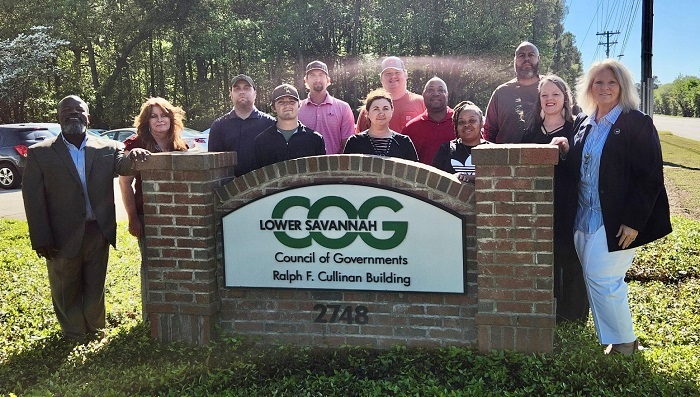 The Lower Savannah Council of Governments has provided key support for the Savannah River Site Apprenticeship School since 2020.
Apprenticeships allow companies to establish a learning pathway for participants while they pursue a technical education and obtain paid on-the-job experience. Through this partnership, funds from LSCOG have been used to enroll 75 Workforce Innovation and Opportunity Act (WIOA) participants and have provided over $42,000 in supportive services to the program.
“This partnership continues to serve as an employment solution with local, regional and state-wide impact,” said William Molnar, LSCOG executive director. “We are proud to support these programs as they improve access and success for diverse populations — leading to lifelong careers at the Savannah River Site.”
Established in 1967, LSCOG serves Aiken, Allendale, Bamberg, Barnwell, Calhoun and Orangeburg counties. Apprentices who live in the region are enrolled into WIOA — which funds the LSCOG-Workforce Division — to support their participation in the SRS Apprenticeship School. The WIOA funds enable the apprentices to receive tools, uniforms, travel vouchers and need-related payments.
“The support we receive from LSCOG Workforce Development is incredibly beneficial to our program and the important missions we serve for the Department of Energy,” said Sean Alford, SRNS executive vice president and chief administrative officer. “Our collective efforts have resulted in a viable workforce and job opportunities that will continue to help fill a wide range of positions with qualified candidates.”
Several of the region’s two-year post-secondary institutions participate in the SRS Apprenticeship School, including Aiken Technical, Denmark Technical and Augusta Technical colleges. SRS apprenticeships offer a successful alternative or complement to a traditional four-year degree program.
For more information about the SRS Apprenticeship School, click this blue box:
-Contributor: Mackenzie McNabb
 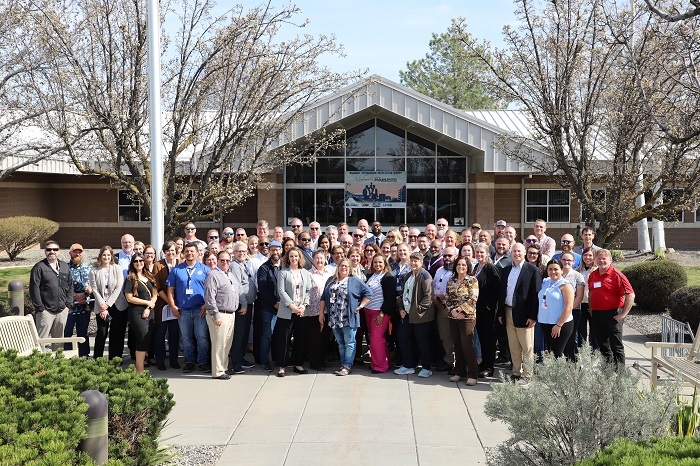 The HAMMER Federal Training Center and Pacific Northwest National Laboratory co-hosted this year’s annual meeting of the Training Working Group, which is part of the Energy Facility Contractors Group.
RICHLAND, Wash. — The U.S. Department of Energy Office of Environmental Management (EM) HAMMER Federal Training Center and the Pacific Northwest National Laboratory co-hosted this year’s gathering of the Training Working Group of the Energy Facility Contractors Group at the Hanford Site.
The annual meeting included a keynote address from Brian Vance, EM’s manager of Hanford’s River Protection and Richland Operations offices, followed by panel discussions on a wide variety of topics, including HAMMER’s Worker Trainer Program.
“Our workforce benefits from the Worker Trainer Program, which brings current experiences from the Hanford Site into the classroom every day,” said Vance. “By using hands-on training techniques in a realistic and controlled environment, our HAMMER team plays a vital role in the safety of our Hanford teammates as they progress our important cleanup mission.”
 Industrial safety training managers at the Hanford Site’s HAMMER Federal Training Center discuss the Worker Trainer Program during a recent annual meeting of the national Training Working Group, a subgroup of the Energy Facility Contractors Group.
In the Worker Trainer Program, workers with current knowledge of the jobs and hazards at the site train other workers on how to safely conduct high-hazard work.
Panel discussions stressed the importance of partnerships and lessons learned when recruiting worker trainers and the benefits of peer-to-peer instruction to contractors, particularly the enhanced level of experience worker trainers bring to the training environment.
“Our worker trainers are the backbone of the cleanup work and know the importance of good hands-on training to keep themselves and their co-workers safe in a hazardous environment,” said Steve Maiuri, HAMMER training director. “They have a passion for improving worker health and safety and making sure every worker gets back home safely each night.”
HAMMER, which stands for Hazardous Materials Management and Emergency Response, began operations in 1994. The federal training center’s motto is “Training as Real as it Gets!” because staff provide realistic, hands-on training to Hanford workers; military, national and international emergency responders; and U.S. Homeland Security Department personnel.
The Energy Facility Contractors Group supports Department of Energy and National Nuclear Security Administration mission success by sharing best practices and information to support management and operational excellence.
-Contributor: Shane Edinger
 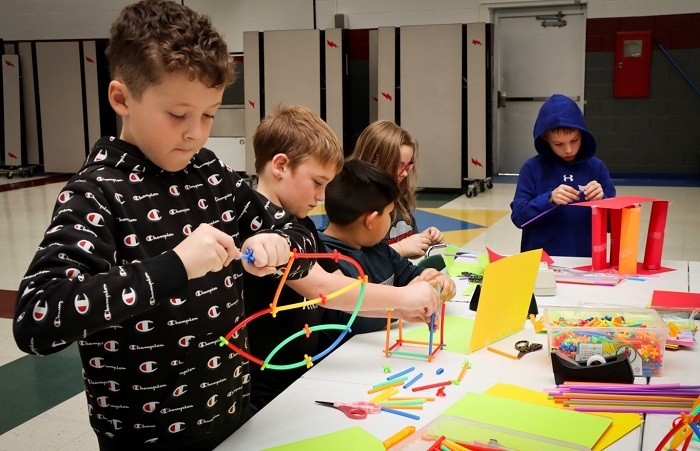 Scioto Valley Local School District students work on problem solving skills at the STEAM Ahead engineering creation station where they learn different engineering techniques to strengthen their structures.
PIKE COUNTY, Ohio — The U.S. Department of Energy (DOE) Office of Environmental Management (EM) Portsmouth Site recently expanded its hands-on learning program by adding Waverly City Schools, now making the initiative part of all four public school districts in Pike County.
The program, called STEAM Ahead, encompasses science, technology, engineering, arts and math. It was created to support the EM commitment to promoting STEAM initiatives and developing an inclusive STEAM workforce of the future.
“We launched the program four years ago to introduce students to the possibilities of science and the wide range of careers to explore,” STEAM Ahead Co-Coordinator Tim Poe said. “We quickly realized this was going to be a big hit, not just with the students, but the teachers and administrators as well.”
STEAM Ahead rapidly expanded to new area schools and welcomed additional community partners, giving the students exposure to a variety of career opportunities.
“We love the hands-on STEAM activities the students engage in,” Eastern Elementary School Principal Matt Hines said. “The volunteers are always prepared with a fun educational activity for our students to explore. I appreciate the efforts DOE makes to invest in our students’ education.”
 Third grade students at Waverly Intermediate School watch to determine whether their theories on a marshmallow in a vacuum are correct. This is the school’s first year in the program.
 |
|
An Eastern Elementary School student takes a turn reading a teleprompter. During STEAM Ahead, students learn about video editing, storytelling and the importance of asking thoughtful questions. |
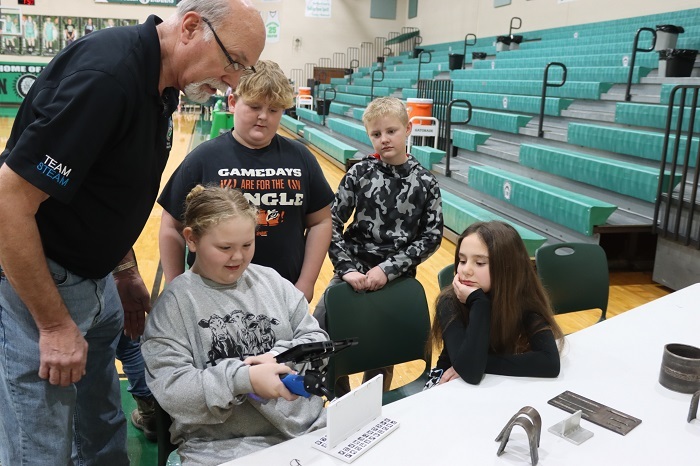 Fluor-BWXT-Portsmouth’s John Albright, a four-year mentor with STEAM Ahead, teaches students about welding with a virtual reality welding program. Western Elementary School hosted the first ever STEAM Ahead and is now in its fourth year of participation.
More than a dozen mentors volunteer their time, providing hands-on experiences featuring physics, chemistry, biology, engineering, video technology, welding and more.
In addition to Portsmouth Site volunteers, the Ohio Environmental Protection Agency, Ohio University, Adena Health System, State Highway Patrol, and The Ohio State University Extension office partner with the program.
“By breaking down the program into smaller groups, we are able to give the students a better experience so everyone can be a part of the hands-on lessons, and the mentors have time to answer the students’ questions,” said Deneen Garner, STEAM Ahead co-coordinator and community relations lead with Fluor-BWXT-Portsmouth, EM’s decontamination and decommissioning contractor for the Portsmouth Site.
The hands-on learning stations keep the students engaged and excited to learn, whether they use teamwork with their classmates to discover new ideas, find solutions through creativity or complete a task with newly developed skills, according to Garner.
“You can see the students are engaged with the presenters while learning and enjoying themselves,” Waverly City Schools Assistant Superintendent Melissa Marquez said. “The variety of activities give the students an opportunity to explore different interests they might not normally experience.”
-Contributor: Cindi Remy
  The U.S. Department of Energy Office of Environmental Management’s canister double-stack project at Savannah River Site’s Glass Waste Storage Building 1 required numerous employees from across Savannah River Mission Completion’s liquid waste workforce. Standing in front of the shielded canister transporter are construction, project management and radiological control representatives.
AIKEN, S.C. — The U.S. Department of Energy Office of Environmental Management (EM) and its liquid waste contractor at the Savannah River Site (SRS) have completed canister storage modifications in one of two glass waste storage buildings (GWSB), effectively doubling that facility’s waste storage capacity and avoiding construction of a third storage building.
GWSB 1 consists of a below-grade concrete vault containing support frames for vertical storage of the canisters, which are 10 feet tall, 2 feet in diameter and filled with radioactive waste mixed with glass produced at the Defense Waste Processing Facility. The building is also seismically qualified, meaning it was built to withstand and operate after an event such as an earthquake.
Jim Folk, DOE-Savannah River assistant manager for waste disposition, said the changes support progress toward safely moving the liquid waste mission forward.
“By doubling the space available for canister storage, we achieved an estimated cost savings that exceeds $100 million, as each of these buildings has been built to strict safety standards,” Folk said.
 The canister double-stack project at Savannah River Site modifies each canister storage position to provide enough room to add a second canister on top of the first, saving more than $100 million by deferring the expense of constructing another storage building.
Canister storage capacity in GWSBs 1 and 2 is less than the projected number of canisters expected to be produced to complete the site’s liquid waste mission. Radioactive liquid waste is generated at SRS as byproducts from processing nuclear materials for national defense, research, medical programs and for NASA missions. The waste — totaling 33 million gallons — is stored at SRS in two groupings of underground waste tanks known as tank farms.
An evaluation in 2015 concluded that, with some minor changes to each vertical position in GWSB 1, two canisters could be stored one on top of the other in an area previously used to store only one. Double-stacking canisters would allow for completion of the mission using existing space without construction of additional storage buildings.
In GWSB 1, space in all 2,262 original storage positions have now been modified to allow storage of a total of 4,524 canisters.
EM liquid waste contractor Savannah River Mission Completion (SRMC) completed the modification work. To achieve double-stack modifications, workers used a specially designed cutting tool to remotely remove an existing steel crossbar from each canister support. The elevated crossbar is replaced with a plate that rests on the storage vault floor. This change increases the height available and allows stacking of canisters.
The glass waste storage buildings are for interim storage of canisters, which are destined for final disposal in a future federal repository.
SRMC President and Program Manager Dave Olson said the canister double-stack project demonstrates exceptional work by SRMC employees.
“Our workforce has safely performed this necessary work inside Glass Waste Storage Building 1,” Olson said. “Our work continues as we seek safe and innovative methods to complete our mission by 2037. Further, these cost savings allow additional funds to be used for tank cleanup and closure.”
Double-stack modification of GWSB 2 is scheduled to begin this month.
-Contributor: Jim Beasley
|



